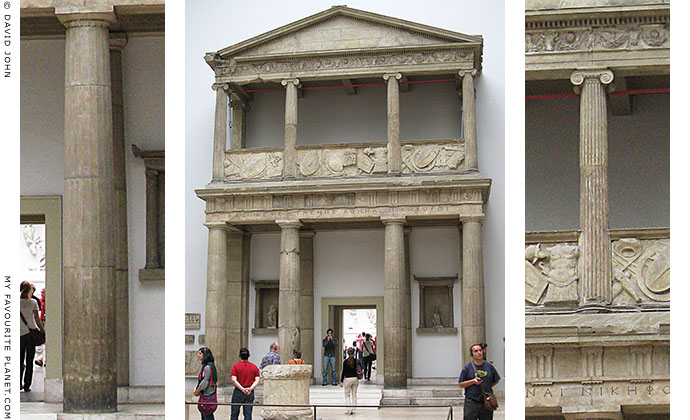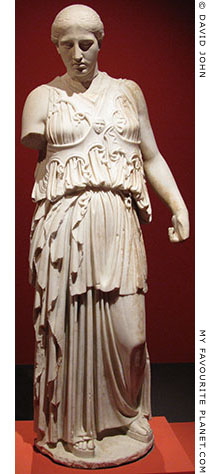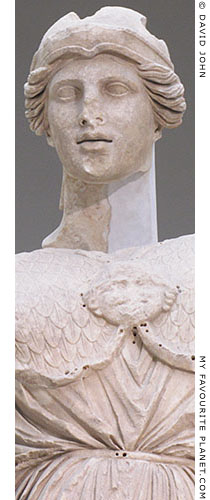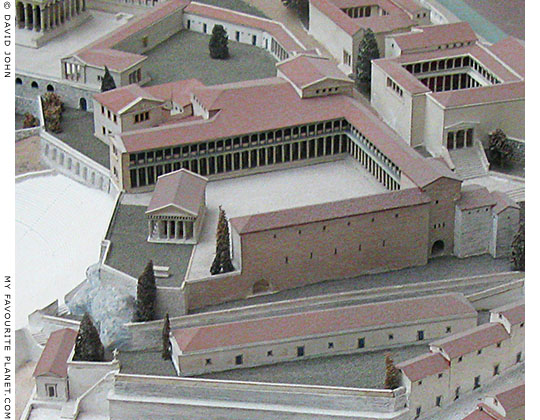The propylon (πρόπυλον, that which is before the gate) of the Sanctuary of Athena Polias Nikephoros (Ἀθηνᾶ Πολιάς Νικηφόρος, Athena of the City, Bringer of Victory) from the Pergamon Acropolis. The monumental gateway, which stood at the northeast corner of the sanctuary, was built by Eumenes II in the early 2nd century BC.
The two-storey building had a porch of four Doric columns (tetrastyle) on the ground floor, above which was a dedicatory inscription by Eumenes to Athena Nikephoros. The upper storey was a balcony with four Ionic columns and fronted by a military frieze depicting armour and weapons. See a close-up of the frieze and inscription above the entrance on the next page.
Standing on the southwest corner of the walled citadel on the Acropolis, the Sanctuary of Athena Nikephoros was one of Pergamon's oldest religious centres, used for the worship of Athena and Nike. (See more information about the relationship between Athena and Nike in the article about The Temple of Athena Nike, Athens on Athens Acropolis gallery, page 11.)
Athena's cult at Pergamon was associated with the city's mythical founder Telephos, the son of Herakles and Auge, who was a priestess of Athena. The Attalid rulers of Pergamon claimed to be descendants of Telephos, and thus of Herakles and Auge.
In the first half of the 3rd century BC Philetaerus (Φιλέταιρος, circa 343-263 BC), the city's first Attalid ruler, built a a Doric peripteral (columns all around) temple on a base of two steps. Made of local andesite, it measured 12.72 x 21.77 metres, with 6 columns front and back, and 10 columns along each side. It was probably modelled on the larger archaic Temple of Athena in nearby Assos (6th century BC), which until Hellenistic times was the only peripteral Doric temple in Asia Minor. A large marble altar stood in front of the temple, on its southwest face.
From around 226 BC Attalus I Soter (269-197 BC) commissioned large monuments, consisting of bronze statues and statue groups, in the centre of the square to the east of the temple to celebrate his victories over the Galatians, who he finally defeated around 227 BC. It is thought that the sculptor Epigonus of Pergamon (Ἐπίγονος), perhaps a court sculptor to the Attalids, had overall responsibility for this project. One of the bronze statue groups depicted conquered and dying Gauls. The famous marble statues "the Dying Gaul" and the "Ludovisi Gaul", now in museums in Rome, are thought to be copies of sculptures from this group.
During the reign of Eumenes II, the sanctuary precinct (temenos) was surrounded by adjoining colonnaded porches (stoas) on its north, east and south sides. Like the propylon, the stoas consisted of two storeys, with Doric columns on the ground floor and Ionic columns on the first floor. The west side of the precinct was free so that the temple could be seen and admired from below the Acropolis and the surrounding countryside.
The Pergamon Library (also known as the Athenaeum) was built on the north side of the northern stoa, and the propylon provided the entrance to the library and temple precinct. (See the photo of the model of the temple, sanctuary and library below.)
Eumenes II also founded the Nikephoria festival and games centred on the Sanctuary of Athena.
According to Plutarch, in the 1st century BC Mark Antony (83-30 BC) was accused by Calvisius, one of his enemies in Rome, of taking the 200,000 volumes of Pergamon's library as a gift for Cleopatra. [1]
During the Byzantine era a church was built in the sanctuary, abutting the east side of the temple.
The propylon has been restored and reconstructed in the Pergamon Museum, Berlin.
See also photos and information about the Propylaia of the Athens Acropolis on Athens Acropolis gallery, page 10. |
|








